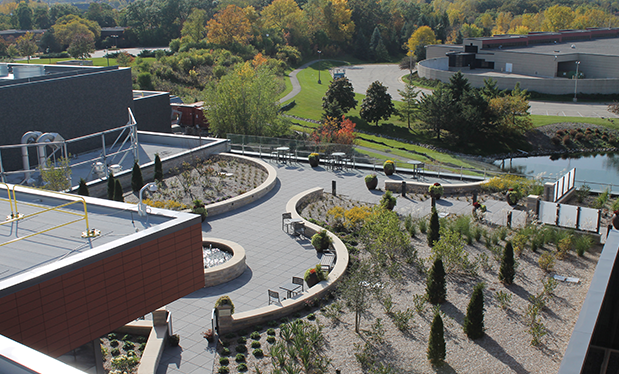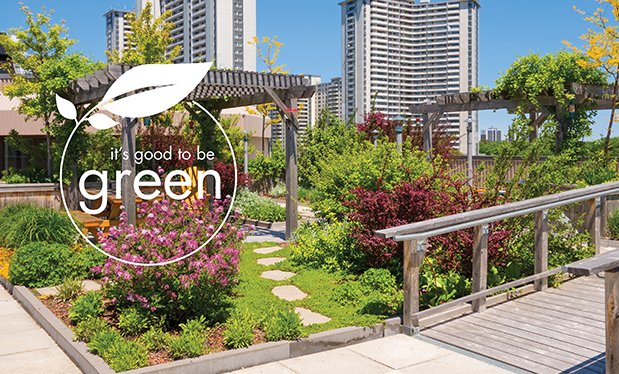Most people in the construction industry are familiar with the U.S. Green Building Council's Leadership in Energy and Environmental Design (LEED) system. LEED is the most widely known "green" building certification system. Since the LEED program began in 1993, more than 44,000 projects have been registered and/or certified in the U.S.
Despite its success, the LEED system is not without its critics who say the program is too expensive; the certification process takes too long; the documentation necessary for project certification is too bureaucratic and time-consuming; and energy savings predicted in LEED system modeling are not always achieved in actual building operations.
Other green building certification systems in the U.S. are beginning to gain traction. The most established of these alternative systems is the Green Globes Environmental Assessment and Rating System—commonly known as Green Globes. In 2004, the Green Building Initiative (GBI) acquired the U.S rights to the Green Globes building assessment and certification program and adapted it for the U.S. market as an alternative to the LEED building rating system.
Green Globes in the U.S.
As of May 2016, there are 798 Green Globes-certified buildings in the U.S. There currently are three Green Globes rating system types:
- New Construction
- Existing Buildings
- Sustainable Interiors (does not address roof system components)
To be eligible for Green Globes certification, a building must meet the following criteria:
- Be designed for occupancy
- Have conditioned space
- Be at least 400 gross square feet
- Have less than 18 months of occupancy (new construction)
- Have 12 consecutive months of normalized operational data within the previous 18 months (existing building)
Opportunities for roofing
Of the 798 Green Globes-certified buildings, 353 are certified as part of the New Construction rating system. According to GBI, the New Construction rating system "aids architects, engineers, construction professionals, owners, and building operators to evaluate and improve the environmental friendliness and sustainability of new building projects as major renovation and additions."
Of the three Green Globes rating system types, the New Construction rating systems offers the most opportunity for roof system components to be part of Green Globes-certified buildings.
New construction process
Initial stages of Green Globes-related activities take place before construction and usually before involving roofing contractors. A typical scenario involves design teams registering projects with GBI. Once projects are registered and the design phase has begun, project teams complete online surveys. The purpose of online surveys is to collect information regarding a project's desired environmental and sustainable characteristics, programs, policies and technologies. Surveys are used as part of the assessment process to provide feedback to design teams regarding potential criteria and points most compatible with project goals.
Once online Construction Document Surveys and supporting project documents are completed and submitted for review, third-party assessors conduct Stage I Design Reviews, which involve analyses of online survey results, construction documents and supporting documentation.
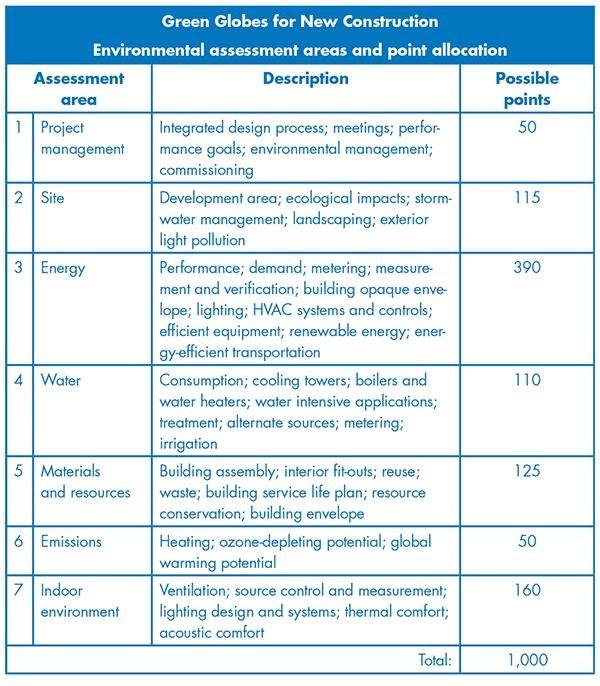
Figure 1: Green Globes assessment areas for New Construction |
At the conclusion of Stage I Design Reviews, assessors issue reports that typically contain the following:
- All points verified
- Points still needing verification
- A preliminary (nonfinal) score
- Projected rating
- Project recommendations
Projects are evaluated and points awarded according to the environmental assessment areas shown in Figure 1. Green Globes certification levels are based on points earned as a percentage of total possible points (see Figure 2). The Green Globes system allows third-party assessors flexibility to exercise professional judgment when determining points and are permitted to award partial credit depending on the level of achievement. Another aspect of Green Globes is recognition of nonapplicable criteria. It is permissible for design teams to designate certain provisions within each assessment area as "non-applicable (N/A)" when completing online surveys at the beginning of projects. During Stage I Design Reviews, third-party assessors validate N/A survey responses according to the following four primary justifications:
- Regional/climatic applicability
- Jurisdictional/code conflict or inconsistency
- Building occupancy type
- Criteria that address a facility, design feature, or building appurtenance that is not designated or used for that particular project space, or is completely outside the control or influence of the client
Provisions deemed N/A by third-party assessors according to these justifications are removed from consideration. This is important because the levels of final project certifications are based on the percentages of applicable points earned.
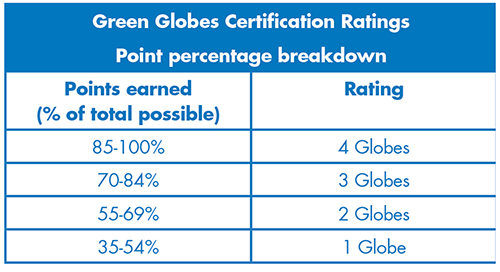
Figure 2: Certification ratings |
For example, suppose a project is awarded a preliminary score of 800 points out of a possible 1,000 points (80 percent). According to Figure 2, such a project would have a preliminary rating of 3 Globes. Let's further suppose 100 potential points are deemed N/A by the third-party assessor. In this case, the preliminary score would be 800 out of a possible 900 points (89 percent)—a preliminary rating of 4 Globes.
It's important to note results reported in Stage I Design Reviews are preliminary. Final certification and a rating only are issued after Stage II On-site Assessments.
Before on-site assessments, post-construction surveys are completed by design teams as well as submission of additional documentation if requested by third-party assessors. This often is necessary because of changes that typically occur during the course of construction. GBI endeavors to assign the same assessor for Stage I Design Reviews and Stage II On-site Assessments; site visits typically require at least 30 days' advance notice.
It is common practice for third-party assessors to be in contact with design and/or construction teams in the weeks before on-site assessments to coordinate access, an itinerary and design and/or construction team members required to attend assessments. Typically, this group would include someone knowledgeable about roof system materials and design as these elements are integral to building envelopes—an important part of energy conservation and sustainability strategies.
During on-site assessments, third-party assessors conduct introductory meetings, review documentation, conduct walk-throughs of project buildings and sites, and interview personnel. After the visit, third-party assessors issue findings and recommend a final score and rating to GBI. Once approved, final reports, scores and ratings are issued.
Roofing-related aspects
Although project criteria and assessment goals for Green Globes generally are determined before selecting and involving roofing contractors, it is important to realize Green Globes projects may involve documentation and practices that are unfamiliar to roofing contractors.
Before bidding and construction take place, roofing contractors should examine construction documents to determine how Green Globes compliance-related information is to be collected and reported. There may be project requirements for Green Globes compliance-related submittals or coordination meetings. Additionally, contractors may be required to practice certain management techniques to demonstrate compliance with project environmental risk assessment strategies.
Not all Green Globes projects use all the requirements or attempt to qualify for all possible points. It is important to evaluate construction documents so the full range of Green Globes-related requirements and contractor responsibilities can be determined. Understanding project-specific Green Globes-related requirements are critical to adequately staff projects and manage required documentation because these requirements typically are more substantial than non-Green Globe projects.
Existing buildings process
Of the 798 Green Globes certified buildings, 434 are certified as part of the Existing Buildings rating system. This rating system type is appropriate for existing buildings that meet the general eligibility requirements for new construction. The rating system is designed to identify choices when considering capital improvements or implementation of best sustainability practices.
Initial stages of Green Globes for Existing Buildings processes involve building owners' property management teams completing comprehensive surveys designed to help evaluate opportunities to save energy, reduce environmental effects, integrate corporate goals and practices, and lower maintenance costs.
Based on survey results and input from GBI, third-party assessors conduct site visits of subject buildings to provide guidance, recommend ways to streamline operations and offer suggestions for future capital improvements to advance sustainability features.
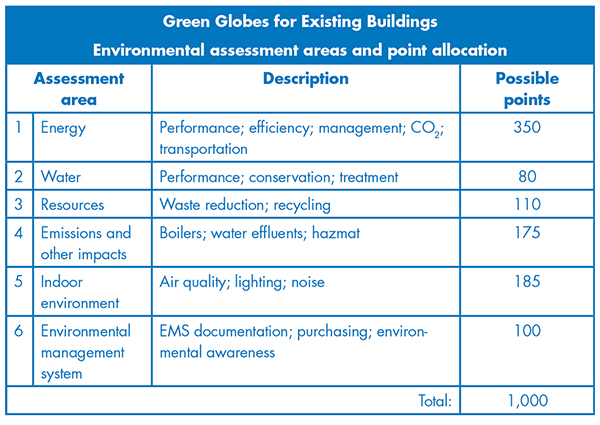
Figure 3: Green Globes assessment areas for Existing Buildings |
Projects are evaluated and points awarded in a similar way to the Green Globes for New Construction rating system though environmental assessment areas and point breakdowns are modified to better reflect existing buildings. Environmental assessment areas and point breakdowns are shown in Figure 3.
Generally, the Green Globes for Existing Buildings rating system offers fewer opportunities for roofing contractors to contribute (compared with New Construction projects) because not all projects include roof system replacements. Repairs or maintenance to existing roof system components may be identified as desirable sustainability enhancements and, therefore, are part of the overall Green Globes for Existing Buildings certification even when full roof replacement is not within the scope of projects. For particular projects, potential roofing-related assessment area criteria are similar to those in the New Construction rating system.
Federal agencies
Since 2006, federal agencies owning and operating more than 90 percent of federal facilities have signed a Federal Leadership in High Performance and Sustainable Buildings Memorandum of Understanding. This document has become known as the Guiding Principles contained in the first set of environmental performance goals developed in 2006 to be considered when designing and building new federal buildings. In 2008, the Guiding Principles were updated and expanded to include new construction and existing buildings.
Additionally, on March 19, 2015, President Obama signed Executive Order (EO) 13693, "Planning for Federal Sustainability in the Next Decade." EO 13693 reaffirmed federal green building efforts and "called for revised Guiding Principles to reflect progress in green building design, construction, and operation practices; broaden considerations around protecting occupant health, wellness, and productivity, and address climate change risks."
To establish how a green building rating system may be used to demonstrate compliance with the goals of the Guiding Principles, the Department of Energy (DOE), as noted in the Federal Register Oct. 14, 2014, Vol. 79, No. 198, determined LEED and Green Globes are appropriate systems to demonstrate compliance with goals related to the Guiding Principles.
DOE states: "DOE is not requiring Federal agencies to use a green building certification system. Federal agencies may wish to use a green building rating system as a tool to help them meet the Guiding Principles or their own internal sustainability goals, although agencies are not required to use such a system, DOE encourages Federal agencies to consider the General Services Administration's (GSA's) 2013 recommendations when choosing a green building certification system."
Also the Federal Register Vol. 79, No. 198, notes: "Subsequently, on October 25, 2013, GSA recommended that Federal agencies achieve at least a Silver rating from LEED or 2 Green Globes from the Green Building Initiative for new construction and/or major renovations in order to meet the statutory criteria."
Green Globes also is identified as one of three third-party certification systems reviewed or required by select federal agencies in the U.S. Government Accountability Office's (GAO's) July 2015 report, "Federal Green Building: Federal Efforts and Third-Party Certification Help Agencies Implement Key Requirements, but Challenges Remain," to the Senate Committee on Homeland Security and Governmental Affairs. The other systems identified in the report are LEED and Living Building Challenge (administered by the International Living Future Institute).
As evidenced by the GAO, the federal government is committed to building and maintaining high-performance and sustainable buildings. Using third-party certification systems such as Green Globes is an acceptable way to demonstrate compliance with statutory criteria for sustainability and high-performance buildings.
Final thoughts
Although Green Globes has far fewer building certifications compared with LEED, the Green Globes system has some interesting attributes missing from LEED—most notably the on-site evaluations of completed projects. It seems likely roofing contractors will increasingly encounter projects with Green Globes-based requirements because Green Globes is the most established third-party certification system in the U.S. for those looking for an alternative to LEED. And government agencies also seem likely to at least consider using Green Globes after recent acknowledgment by DOE, GSA and GAO.
NRCA recommends roofing contractors approach projects with Green Globes-based requirements the same way they approach other third-party certification system-based projects: Study construction documents carefully to ensure the full range of Green Globes-based contractor responsibilities are identified and planned for because those responsibilities are likely beyond the typical responsibilities of which roofing contractors are accustomed. Additionally, it is wise to ask for clarification where bidding documents lack specificity regarding how sustainability or high-performance building goals are to be met.
Jason Wilen, AIA, CDT, RRO, is an NRCA director of technical services.
A brief history
Green Globes has its origins in the Building Research Establishment Environmental Assessment Method (BREEAM), which is purported to be the world's longest established method of assessing, rating and certifying buildings' sustainability. BREEAM was first published in 1990 by BRE (Building Research Establishment), Watford, England. According to BREEAM's website, www.breeam.com, there are more than 2 million registered BREEAM buildings worldwide in 77 countries.
The Canadian version—BREEAM Canada—was published in 1996, and in 2000, Green Globes for New Buildings Canada was established with support from the Canadian Department of National Defense and Public Works and Government Services.
In 2004, the Green Building Initiative (GBI) adapted Green Globes for the U.S. market and released the first version that year. GBI is a 501(c)(3) nonprofit organization, and in 2009, it became the first building rating organization to become an American National Standards Institute (ANSI) developer. The ANSI process is used to develop many documents for the construction industry.
According to ANSI: "American National Standards (ANSs) are developed in an environment that is equitable, accessible and responsive to the requirements of various stakeholders. The open and fair ANS process ensures that all interested and affected parties have an opportunity to participate in a standard's development. It also serves and protects the public interest since standards developers accredited by ANSI must meet the Institute's requirements for openness, balance, consensus and other due process safeguards."
Using the ANSI process, GBI facilitated the creation of ANSI/GBI 01-2010, "Green Building Assessment Protocol for Commercial Buildings," of which the current version of the Green Globes for New Construction rating system is based. The standard currently is under review using ANSI's periodic maintenance process.
According to GBI's website, thegbi.org, the benefits of Green Globes certification include the following:
- Real-time customer support
- Online tools that speed and simplify the assessment process
- Comprehensive assessment roadmap
- On-site third-party building assessment
- Best practices guidance for green construction and operations
Third-party assessors
The following information about third-party assessors appears in the Green Building Initiative's (GBI's) Green Globes
for New Construction Technical Reference Manual—Version 1.4:
"Green Globes Assessors are sustainability experts, generally with more than 10 years of applicable industry
experience, who have successfully completed GBI's Green Globes Assessor Training Program. Once certified, Green
Globes Assessors are authorized to perform Green Globes and Guiding Principles Compliance assessments for GBI as
independent contractors. Their professional judgment is critical in the assessment process to verify point awards, to
determine criteria applicability, as well as to provide sustainability recommendations within their assessment
report. Once assigned, the client has direct access to contact the assessor for assessment guidance. Although GBI
assigns Green Globes Assessors to projects, the assessor decisions and recommendations are not revised or redirected
by GBI, thus ensuring assessor autonomy and their third-party status."
Cost comparison
Green Globes sometimes is touted as a less expensive alternative to LEED. Although there currently is no cost-comparison data available from the U.S. Green Building Council related to Green Globes and LEED projects, the Green Building Initiative recommends a report by Jeffrey L. Beard, Ph.D., associate professor for the department of construction management at Drexel University's College of Engineering, Philadelphia, titled "A Study of Comparative Sustainability Certification Costs—Green Rating System Cost Comparison Study: LEED and Green Globes." The report is available online at www.thegbi.org/content/misc/Drexel_Building_Study_2014.pdf.
Roofing-related categories
Many potential Green Globes for New Construction point requirements can include roofing-related materials and practices. For a particular project, the most likely potential roofing-related assessment area criteria as noted in Green Globes for New Construction Technical Reference Manual—Version 1.4 are contained in the following requirement categories:
- 3.1.2.1 Environmental Management System (EMS). This category may contain requirements for job-site conduct and training.
- 3.1.2.3 Building Materials and Building Envelope. This category may contain requirements for roof system component handling, storage and installation.
- 3.1.3 Commissioning. This category may include building envelope commissioning requirements that can include roof system components.
- 3.2.2.4 Heat Island Effect. This category may include requirements for vegetative roofing or exposed roof system components with a high solar reflectance index.
- 3.2.4 Landscaping. This category may contain vegetative roof system requirements.
- 3.3.1 Energy Performance. This category may contain roof system-specific energy-performance requirements related to component selection and installation.
- 3.3.4 Building Opaque Envelope. This category likely contains roof system thermal insulation requirements.
- 3.3.4.3 Fenestration System. This category may contain skylight requirements.
- 3.3.5.4 Daylighting. This category may contain skylight requirements.
- 3.3.9.1 On-Site Renewable Energy. This category may include requirements for rooftop photovoltaic systems.
- 3.5.1 Building Core and Shell. This category may require documentation related to the anticipated environmental impact of roof system components. Environmental Product Declarations (EPDs) often are used for this purpose. (For more information about EPDs, see "What do you declare?" November 2014 issue.)
- 3.5.4.1 Construction Waste. This category may contain mandatory procedures for construction waste management on site, material recycling, salvaged materials and transporting waste materials.
- 3.5.5 Building Service Life Plan. This category may require documentation related to estimated service life and projected maintenance of roof system components.
- 3.5.7 Building Membrane Assemblies and Systems. This category requires roof system components be installed per manufacturers' instructions and may require some level of on-site observation of roof system component installation. The NRCA Roofing Manual is included as a technical reference.
- 3.5.7.2 Flashings. This category requires building envelope flashings and sheet-metal assemblies be installed and inspected per prescribed industry best practices.
- 3.5.7.3 Roof and Wall Openings. This category requires roof and wall openings products comprise moisture-management design and meet prescribed performance and inspection requirements. The NRCA Roofing Manual is included as a technical reference for skylight flashings.
- 3.5.10.1 Air Barriers. This category requires air barrier location, materials, system and joints be detailed and specified in construction documents and designed to reduce the uncontrolled air movement through a building's envelope.
- 3.7.2.1 Volatile Organic Compounds (VOCs). This category requires single-ply roof membrane adhesive to have a maximum VOC content of 250 grams per liter (g/L). Single-ply roof membrane sealant is permitted to have a VOC content as high as 450 g/L. The South Coast Air Quality Management District Rule 1168, "Adhesive and Sealant Applications," is included as a technical reference.

